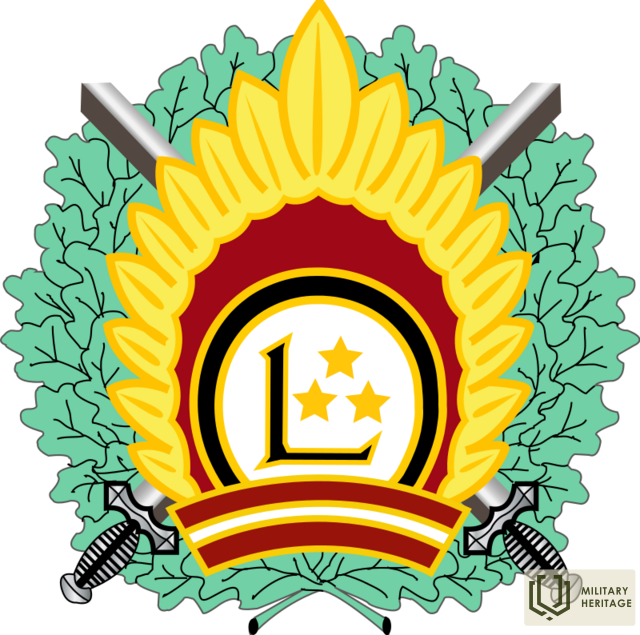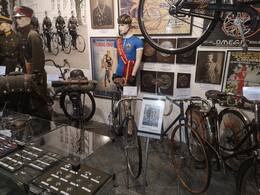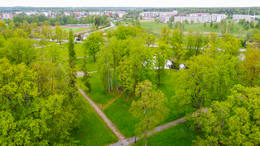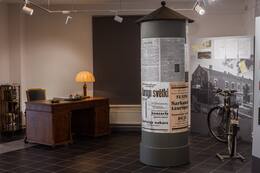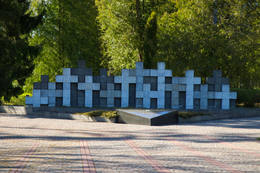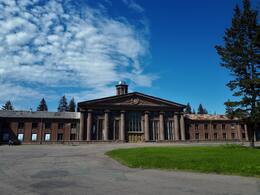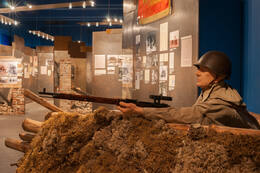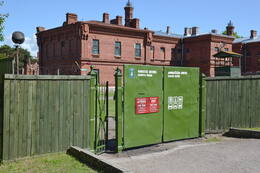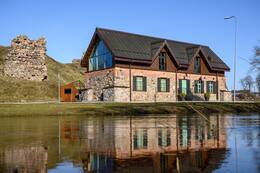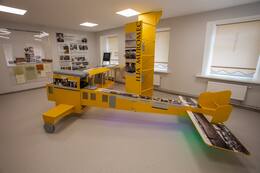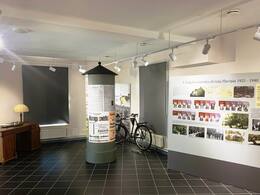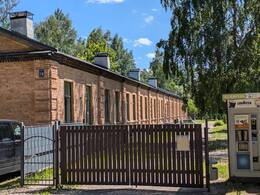Latvian Army
I Wars of Independence, Independence of the Baltic States, II World War II
On January 5, 1919, the first major national military unit was formed – the Separate Latvian Battalion under the command of Lieutenant Colonel Oskars Kalpaks. This unit, which was reorganized into a brigade in March, together with the Northern Latvian Brigade, organized in Estonia and commanded by Colonel Jorgis Zemitāns, formed the Latvian Army. The newly formed army grew and hardened in battles against the Bermontites near Riga and in Courland, as well as in battles against the Bolsheviks on the Latgale Front.
A week after the end of World War I and the conclusion of the Armistice of Compiègne on November 11, 1918, the establishment of an independent Latvian state was proclaimed. The new provisional government had hoped that it would be able to do without the formation of a regular army, since it did not intend to attack anyone. On November 13, 1918, Soviet Russia annulled the Treaty of Brest-Litovsk, by which it had renounced the Baltic territories in favor of Germany, and began its advance towards the West. Hopes that the German army would fulfill its commitment to defend Latvia against the Bolshevik invasion were not justified.
Meanwhile, troops loyal to the Provisional Government of the Republic of Latvia were forming in Riga. In the spring of 1919, the Latvian armed forces consisted of the Landeswehr (Baltic German national guard), the North Latvian Brigade and the South Latvian Brigade. Both of these brigades were united on July 10, 1919 by General Dāvis Sīmansons, who became the first Commander-in-Chief of the Latvian Army. This day is considered the day when the Latvian Army was established.
In 1919, the Latvian army underwent rapid rearmament and development, with armaments and equipment received from England, Poland and other countries. At the beginning of 1920, approximately 52,000 soldiers served in the Latvian armed forces. The War of Independence ended on August 11, 1920, when a peace treaty with Soviet Russia was signed. Immediately after the War of Independence, the Latvian army began to transition to a peacetime state. The Latvian army included four infantry divisions with three infantry regiments and an artillery regiment in each. The infantry regiments were numbered and named after Latvian cities. The Latvian army also had a navy, which consisted of the flagship “Virsaitis”, a Submarine Division with two submarines “Ronis” and “Spīdola”, as well as a Mine Division with two mine trawlers “Imanta” and “Viesturs” and several auxiliary vessels.
The composition of the army was formed on the basis of general conscription, to which all Latvian citizens were subject. Until 1931, the service period was 18 months, later it was shortened to 12 months for infantry, 15 – for other branches of arms. The army and navy were managed by the Ministry of War. The Minister of War was subordinate to the army commander, who was responsible for the training and preparation of the army.
On June 1, 1940, the Latvian Army had 30,843 men. On June 17, 1940, during World War II, the Soviet Union took control of all of Latvia and Estonia. The Latvian Army was gradually disbanded, with Latvian soldiers being retired, arrested, and deported. On September 27, 1940, the post of Minister of War of Latvia was abolished, and on October 9, 1940, the post of Commander of the Latvian People's Army was abolished.
On June 17, 1989, in Riga, in the Great Hall of the Latvian State University, the founding conference of the Latvian Riflemen's Union was held. After which, within a few weeks, more than 500 former soldiers joined the Latvian Riflemen's Union. In the fall, departments and groups were formed in Jelgava, Tukums, Liepāja, Bauska, Balvi, Līvāni, Moscow and elsewhere. Active work began on the creation and development of laws, regulations and various documents that would be necessary for the creation and existence of the army.
On September 10, 1991, the law on compulsory military service was adopted. According to this law, all Latvian citizens - men, aged 19 - 50, must perform compulsory military service. Shortly after the adoption of this law, on November 11, at the Brothers' Cemetery, the first soldier's oath was taken since the restoration of Latvia's independence.
More information sources
1. 100 Events in the History of Latvia. People and Processes 1918-2018. AS “Latvijas Mediji”, 2018.
2. Blizzard of Souls. Digital Museum. Available: https://www.dveseluputenis.lv/lv/laika-skala/notikums/105/sarkanas-armijas-iebrukums-latvija/ [accessed: 08.05.2021.].
3. National Armed Forces website. Available: https://www.mil.lv/lv/par-mums/vesture [accessed 08.05.202
Related objects
Exposition of military bikes in the Bicycle museum in Saulkrasti
The Bicycle Museum is located in Saulkrasti not far from the A1 highway and the railway station Pabaži, near the White Dune. Museum’s collection is made up of technically the most interesting examples of bicycle development history in Latvia. It is the largest bicycle collection in the Baltics with about 60 bicycles made and used in Latvia, including army-type bicycles. In the beginning of the 20th century many armies started to widely utilise the availability and benefits of bicycles. Special bicycle units were formed because of their mobility. Bicycle units were able to gather intelligence and launch unexpected attacks more easily, and were more mobile than regular infantry when it came to operations over a wide area. After World War I the Latvian Army also had bicycle units who used Latvian-made army bicycles. Any soldier who was in such a bicycle unit had to meet strict requirements. Good stamina, eyesight and hearing, as well as a healthy heart and lungs were a must. They could not weigh less than 80 kg and their height had to be 165-180 cm. The standard in the Latvian Army was that a well-trained cyclist should be able to cover 80-100 km in day, and up to 150 km in forced conditions. In winter, when bicycles could not be used, skis were used. A soldier from a bicycle unit had to be able to ski 50-60 km per day. Many soldiers from bicycle units would later become professional athletes.
We have about 5000 visitors every year.
Monument to the first battle for Latvia's independence
Located in Inčukalns, Atmodas Street 2.
On July 3, 2016, a monument to the first battle for Latvian independence was unveiled, dedicated to the Latvian Landeswehr (Die Lettländische Landeswehr), in which local Baltic Germans, Russians and Latvians, who were in units on both sides at the time, defended the newly founded state against the Bolshevik Red Army. Eižens Upmanis, the chairman of the Brothers' Graves Committee, concluded at the time that this could be the first monument to the combined Latvian and Baltic German forces in battle memorials outside the cemeteries. At that time, Lieutenant Colonel Oskars Kalpaks was appointed commander of the Latvian units of the Latvian Landeswehr, from whose units the later Latvian Army grew and formed during the Freedom Struggle.
In 1918, the entire territory of present-day Latvia had fallen into the hands of the German Empire and its troops. However, in the late summer and autumn of 1918, the situation began to rapidly turn against Germany and it was clear that it was only a matter of time before Germany would be forced to admit defeat in World War I. The Russian Empire, which Latvia was part of until World War I, had ceased to exist earlier, with the February and October revolutions of 1917. On 18 November 1918, the Republic of Latvia was proclaimed. The German army, which was located in the territory of Latvia, after the armistice with the Entente powers on 11 November 1918, was no longer motivated for further hostilities and most of its soldiers simply wanted to return to their homeland.
Under such circumstances, it was clear that the defense of Latvia depended primarily on a national guard formed by the Latvian population itself. Initially, due to their education and relatively greater ability to self-organize, the Baltic Germans living in Latvia showed the greatest initiative in forming such a national guard. Russian soldiers also joined the national guard. In order to ensure the supply of the national guard with uniforms, weapons and other necessary resources, the Latvian Provisional Government concluded an agreement with the German representative Augustus Vinnig on December 7, 1918, providing for the provision of the national guard from the German army reserves located in the territory of Latvia. This agreement indicated, among other things, that this national guard, with the official name “Latvijas zemessardze” or in German – “die Lettländische Landeswehr”, would be the armed forces of the Republic of Latvia.
The Latvian National Guard was confronted by two Latvian Red Riflemen regiments (i.e., approximately 2,000–3,000 soldiers) that had previously been experienced in World War I and the Russian Civil War. Despite the Red Army's experience and numerical superiority, the Latvian National Guard held Inčukalna in fierce battles for two days, until finally, on the evening of January 1, 1919, in order to avoid encirclement, it was forced to retreat, losing 43 killed and several wounded, most of whom were captured by the Bolsheviks, where they were killed or died of hunger or disease.
Author: Artis Buks. Material: Fieldstone. The monument is made of a large monolithic stone that was found in Ruļļi near Jelgava.
Latvian Army Summer Camp in Litene
The Latvian Army Summer Camp in Litene is located in the forest in Litene parish, near the Pededze River. The beginnings of the Litene Camp can be traced back to 1935 when the construction of a summer camp complex for the Latgale division of the Latvian Army was started. From May to autumn, several thousand soldiers learned combat tactics and shooting skills in Litene. In the summer of 1941, Latvian Army officers were arrested by Red Army and NKVD troops at an army summer camp in Litene. Several officers were shot on the spot, while others were deported to Siberia. On 14 June 1941, at least 430 officers were arrested and deported to Siberia in the Litene and Ostrovieši camps about 10 kilometres from Litene. The only historical building that has survived from the camp is a food storage facility. Only the foundations remain from the other buildings. There is a viewing platform with the Latvian flag, benches and a well-maintained place for a fire. A demilitarised cannon was installed with the support of the Ministry of Defence and the National Armed Forces. Information boards are in place. The Wall of Pain memorial in the Litene graveyard is also connected with the events at the Litene camp. The YouTube channel of the Latvian Army features a video named ‘Litene, Katyn of the Latvian Army’.
Latvian Military Aviation Airport
Located in the territory of Vecgulbene Manor - in the historical center.
In the interwar period, Gulbene was home to a Latvian army garrison, where the 7th Sigulda Infantry Regiment battalion was stationed. In the mid-1930s, the creation of a military aviation base began, because for the successful operation of military aviation, an extensive network of airfields must be ensured even in peacetime. Airfields are especially important in places where important railway and road junctions have been established. On November 11, 1935, construction of a military airfield began here. In 1937, a newly formed Aviation Regiment unit was stationed in Gulbene, which became the 6th reconnaissance squadron of the Latgale Division, increasing the number of army units near the eastern border of Latvia.
The Orangery building is visible.
Exhibition "Latvian Army in Pļaviņas in the 20th Century."
Located at Odzienas Street 2, Pļaviņas.
The permanent exhibition "Latvian Army in Pļaviņas in the 20th Century" is on display.
The building in Pļaviņas, at Odzienas Street 2, has a long history – from the time when the Stukmaņi wholesaler Hugo Apeltofts began active economic activity there, thus contributing to the development of the city of Pļaviņas, to the moment when the headquarters of the Latvian Eastern Front was established here during the War of Independence. In 1919, it was from Pļaviņas that the operations of Latvian army units against the Red Army in Latgale were led.
In 1934, a memorial plaque was unveiled near this house with the inscription: “In 1919, the Eastern Front headquarters was located in this house, and here General Jānis Balodis assumed the supreme command of the Latvian National Army.” The Soviet government removed and destroyed it in 1940, but on June 16, 1990, with the support of the Pļaviņa branch of the Latvian National Liberation Army, it was restored.
Now, near the former headquarters building, there is a memorial stele dedicated to the 15 knights of the Lāčplēsis War Order born in the Pļaviņa region, and an exhibition "The Latvian Army in Pļaviņa in the 20th Century" has been created inside the premises, which tells about the events during the Freedom Struggles, the activities of the headquarters of the 3rd Latgale Division of the Latvian Army in Pļaviņa, and also provides an insight into the life stories of the knights of the Lāčplēsis War Order.
Not far from the exhibition building is the Latgale Division Headquarters building, which was built in 1913 as the Stukmanu liqueur factory by Count Teodors Medem. In 1919, it was taken over by the P. Stučka regime, where it had also established a prison. After the Bolsheviks were expelled, the building was taken over by the Latvian Army in 1925, which housed the Latgale Division Headquarters. 10 generals and other officers of the Latvian Army spent their military careers in this building. In 1940, the building was taken over by the Red Army. In the post-war years, it housed a school, as well as the municipality. Around 1970, the building began to be used by the production association “Rīgas Apērbs”.
Visiting the exhibition must be booked in advance by calling T. 28442692.
Memorial "Wall of Pain"
Art is found in the Litene cemetery.
On June 14, 2001, the memorial "Wall of Pain" created by architects Dina Grūbe, Benita and Daiņš Bērziņš, stonemasons Ivars Feldbergs and Sandras Skribnovskis was unveiled at the Litene cemetery. It symbolizes the resting place of the soldiers killed in 1941. In October 1988, the ashes of 11 officers murdered by the Soviet army in June 1941 were found in the territory of the former Latvian army summer camp in Sita sila, Litene parish. Although they could not be identified, on December 2, 1989, after being consecrated in a service at the Gulbene Evangelical Lutheran Church, they were solemnly reburied at the Litene cemetery.
11 white crosses, a memorial plaque and information boards.
Spilve airport
Located in Riga, Pārdaugava, in the Spilve meadows near Iļģuciems.
Spilve is famous in the history of military heritage for the grandiose Battle of Spilve in the 18th century and the Spilve airfield. Starting in the 20th century, it was used for testing aircraft, but during World War I it became a witness to the history of Latvian aviation.
During World War I, the Spilve meadows were used by the Russian army's air force for the purposes of fighting the German army. With the creation of Latvia, the airfield became the country's most important air force base and a training ground for pilots. The airfield's previous names were "Spilves Air Port" or "Riga Air Port", later "Riga Central Airport". It was the main airport in Latvia until the opening of the airport "Riga" in 1975.
Perhaps the Spilve airfield near Riga and the dream of reaching for the stars have contributed to the impressive achievements of many Latvian pilots. Perhaps, however, the beginning of Latvian aviation is much older and can be found in Priekule, where a Latvian blacksmith Zviedris made a flight from a church tower with a homemade device.
Today, the Spilve airfield is still in operation. You can see the airport building, built in 1954, which embodies the Soviet classicism or “Stalin Empire” style.
Sources:
Irbītis, K. Latvian aviation and its pioneers. Riga: Zinātne, 2004.
Brūvelis, E. History of Latvian Aviation: 1919-1940. Riga: Zinātne, 2003.
Official website of the state agency "Civil Aviation Agency". Available: https://www.caa.gov.lv/lv/latvijas-aviacijas-vesture-isuma [accessed 22.02.2021].
Latvian War Museum
The Latvian War Museum is located in the Old Town not far from the Freedom Monument in a historic defence building called the ‘Powder Tower’. There are 11 exhibits in the museum. There are various weapons, documents, uniforms, awards, badges and other items detailing the everyday life of a soldier in war. The Latvian War Museum is one of the oldest museums in Latvia. Its origins can be found in World War I. Museum’s collection was made up mainly of personal items of soldiers or items found on battlefields. After Latvia gained its independence the main goal of the museum became to create an exposition on the military history of Latvia and the active role of the population in protecting their land. In 1937 the museum was expanded and was technically one of the most modern museums in Europe at that time. The Powder Tower was one of the fortification towers of Riga. Some evidence dates back to 1330 where it has been mentioned as the ‘Sand Tower’. The tower was destroyed in 1621 when Riga was besieged by the Swedish Army. But in 1650 a new tower for storing gunpowder and weapons was built. After the city’s fortifications were taken down, the Powder Tower remains as one of the most important pieces of evidence of the Riga defence system.
Free State Treasure House
The Treasure House of the Free State is located next to the Rēzekne Castle ruins.
The unique exhibition includes hundreds of different historical testimonies from Latvian and foreign private collections, covering the period from 1918 to 1940, revealing the events in the history of Latgale and Rēzekne. It presents the history of military and civilian awards of the First Free State of Latvia, as well as various organisations related to the activities of state and civic organisations in the period from the Latvian War of Independence to World War II.
The collection of military and civilian awards and insignia of the Latvian Free State on display here is the largest one in Latvia.
The Changing Exhibition Hall is situated on the second floor, where a new exhibition is held at least once per year. To date, visitors have had the opportunity to see a unique collection of porcelain objects, luxury clocks from France and paintings depicting various landscapes of Latgale.
“Jāzeps Baško – Gaisa Fūrmanis” (“Jāzeps Baško – Air Cabman”) Exhibition of Preiļi Museum of History and Applied Arts
The “Jāzeps Baško – Gaisa Fūrmanis” (“Jāzeps Baško – Air Cab man”) exhibition is dedicated to the 125th birthday of General Jāzeps Baško, the commander of the “Iļja Muromec” squadron and the organiser of the Latvian Air Force, and to the 100th anniversary of World War I.
The exhibition of the museum collection resembles a design object – a model of the Ilya Muromets aircraft that has been reduced in size 6 times, with information in the form of texts and images provided on the model. The exhibition is enriched by exhibits from the collections of the Latvian War Museum and newly acquired information from the Latvian State Historical Archive, the Spilve Aviation Museum and private archives of individuals. Jāzeps Baško is rightly one of the most awarded Latvians and pioneers of global aviation. He set 4 global aviation records flying Ilya Muromets aircraft. His name is inscribed in the Louis Blériot Golden Book in Paris, i.e., the Golden Book of the world’s best aviators. Jāzeps Baško was awarded all orders of the Russian Empire of his time, in Latvia – the Order of the Three Stars, 3rd Class, the Order of Viesturs, 2nd Class, the Home Guard Cross of Merit, as well as the highest awards of Czechoslovakia, Estonia, Finland, and Poland.
He served in the army of the Russian Empire, the Bolshevik Red Army, and, in 1921, he joined the Latvian Army. He retired from service after the occupation of Latvia.
Exhibition “Latvian Army in Pļaviņas in the 20th Century”
The exhibition dedicated to the creation of the Latvian Army is located in Plaviņas. The building that houses the exhibition has a long history. With the establishment of the Stukmaņi (now Pļaviņas) railway station, the construction of houses began in the area, and one of them, built in 1900, was the house of the merchant Hugo Appeltoft. The building was built as a merchants’ house, but later, it became the birthplace of the Latvian Army.
In July 1919, during the War of Independence, the building was used as the headquarters of the Latvian Eastern Front. On 17 June 1934, to commemorate this event, a memorial plaque was unveiled at the building with the inscription: “In 1919, this house was the headquarters of the commander of the Eastern Front, and here, General Janis Balodis assumed command of the Latvian National Army.” The plaque was restored on 16 June 1990. On 10 June 2019, a memorial statue dedicated to the recipients of the Order of Lāčplēsis born in Pļaviņas region was erected in front of the former headquarters building.
The exhibition displays information stands with historical photographs, maps and information about the establishment of the Latvian Eastern Front Headquarters.
Latgale Artillery Regiment Army Barracks
The Latgale Artillery Regiment Army Barracks were built as a three-story modern building according to the project of architect Verners Vitands in 1931. This monolithic reinforced concrete building was one of the first in Latvia. They have survived, located in the territory of the Krustpils Manor, next to the castle park. Today, the three-story building that has survived is the unmanaged property of the Jēkabpils municipality. Window openings without windows, entry into the building is not possible, the building can be viewed from the outside. The municipality has carried out roof replacement work. In the future, it is planned to renovate the building by placing various organizations there, and hand it over to entrepreneurs for use.
The Latgale Artillery Regiment consisted of two divisions, each division had two cannon and one howitzer battery, totaling 16 cannons and eight howitzers in the regiment. The remaining artillery units assigned to the regiment were stored in preserved warehouses and were intended for the formation of a third division in case of war.
Riga Garrison Army Tent Camp
Now there are bushes and thickets here, but in the thirties of the last century, the Riga garrison army summer camp was located here. In some places you can still see what look like rectangular ramparts. In these places there were soldiers' tents, arranged in four long rows, with small streets in the middle. At the ends of the rows stood the logos of the garrison units - they were cast from concrete, but the ornaments and inscriptions were made of small, colorful stones. The ramparts around the tents were necessary not only to retain moisture, but also for military purposes. If landing troops entered Mangaļsala, they would be used as trenches under the cover of which to protect the territory from the enemy. Although real military training was taking place here, a romantic idyll reigned in the air, which is also visible in photographs of the time. Young people played volleyball. In the courtyards of the officers' cottages, gazebos and flower beds were well-groomed. The soldiers were visited by their loved ones on weekends, bringing baskets of strawberries and fresh bread. Most meals were eaten outside at tables in the fresh air.
Army town
In this neighborhood, in the late 1920s and early 1930s, the Latvian army built an army camp for officers and soldiers who worked on Mangalsala. Later, the camp, along with the Mangalsala military base, became the property of the Soviet Union. Civilians without a certain status lived here, but later social apartments were created for low-income people. On the right side there was a football field and small gardens, but over time they turned into meadows and swamps. Later, private houses and a car service appeared here. Until the 1960s, Mangalsala was not part of Riga at all, but part of Mangali parish. At that time, people here were engaged in fishing or worked at the army base, because agriculture was practically impossible – the area of arable land on Mangalsala is only 3.8%. Once upon a time, a narrow-gauge railway ran through the camp right along Mangalsala Street, but the street itself was paved. Now the pavement is hidden under a layer of asphalt. At the end of the road is the port area and the former military pier. Army ships were once moored there, and footbridges were built between them.
Can be seen from the outside, walking along Mangaļsalas Street.
Related stories
About the first Commander-in-Chief of the Latvian Army, Dāvids Sīmansons
The essays in the book "Commanders of the Latvian Army" convince us that history is significantly influenced by specific individuals. Although they were at the epicenter of the most important historical events for a short time, true Latvian patriots, with their rich military experience, managed to do a lot in the formation and strengthening of the Latvian army and in the turning points of historical events.
This story is about the first Commander-in-Chief of the Latvian Army, Dāvids Sīmansons (1859-1933).
In memory of Pēteris Radziņš, general of the Latvian Army, two-time Cavalier of the Lāčplēsis War Order
General Pēteris Radziņš was born in Lugaži parish, Valka district, into a simple farmer's family, where he learned to do field work. He was a very smart young man, after graduating from school he decided in favor of war and thus began his army career, saving Latvia from Bermont's troops. P. Radziņš was one of the most outstanding officers of the Latvian army and was awarded numerous Latvian and foreign orders and commemorative signs.
Army presence on Mangalsala
The memories contain vivid impressions of the presence of the Latvian army on Mangalsala. The forts are described, as well as the reinforced concrete fortification built by Sapiers. The memories describe the soldiers' everyday life, the rhythm of life and illustrate the environment on Mangalsala. Visit of Mangalsala and Latvian army soldiers
Memories of the beginning of the creation of the War Museum
The narrator describes the circumstances under which the War Museum was established. The problems and the work of creating collections are mentioned.
United Aviation Day - a true national holiday
The narrator describes one of Latvia's most popular and widely attended events – the Aviation Festival in Spilve. He describes the course and scope of the festival. He emphasizes the popularity of aviation in Latvia.
Par Sudrabkalniņa atklāšanas svētkiem
Ištrauka iš prisiminimų istorijos iš generolo Jāņo Baložo kalbos Sudrabkalninio paminklo atidengimo dieną. Visas tekstas yra atidarymo renginio atpasakojimas, prezidento Kārlio Ulmanio ir generolo Jāņo Baložo kalbos. Prisiminimai pasirinkti, nes juose vaizdingai matyti Sudrabkalnino apylinkėse kovojančios Latvijos kariuomenės būklė.
About Daugavgrīva Fortress
The narrator describes an event in the Daugavgrīva Fortress during World War I, when it was bombed by a German army airship. The fortress was one of the strategic objects that retained its importance until the end of World War II.




